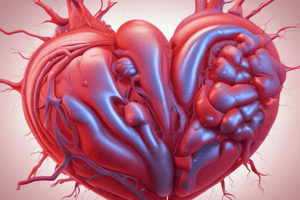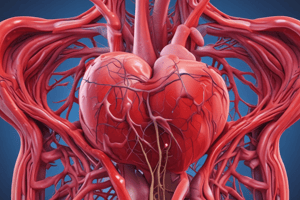Podcast
Questions and Answers
What is the most common cause of death in the first hour after a myocardial infarction (MI)?
What is the most common cause of death in the first hour after a myocardial infarction (MI)?
Which of the following can cause cardiac conduction irregularities after an MI?
Which of the following can cause cardiac conduction irregularities after an MI?
What is the most common complication of an MI that occurs days or weeks later when activity is resumed?
What is the most common complication of an MI that occurs days or weeks later when activity is resumed?
Which of the following is a rare complication of an MI?
Which of the following is a rare complication of an MI?
Signup and view all the answers
What is the approximate mortality rate in the first year after an MI?
What is the approximate mortality rate in the first year after an MI?
Signup and view all the answers
What is the main role of lipids or fats in atherosclerosis?
What is the main role of lipids or fats in atherosclerosis?
Signup and view all the answers
Which of the following is not a risk factor for atherosclerosis mentioned in the text?
Which of the following is not a risk factor for atherosclerosis mentioned in the text?
Signup and view all the answers
What is the main cause of myocardial infarction (heart attack) according to the text?
What is the main cause of myocardial infarction (heart attack) according to the text?
Signup and view all the answers
What is the function of the left anterior descending (LAD) artery, also known as the 'widow-maker'?
What is the function of the left anterior descending (LAD) artery, also known as the 'widow-maker'?
Signup and view all the answers
What is the most specific diagnostic test for myocardial infarction (heart attack) mentioned in the text?
What is the most specific diagnostic test for myocardial infarction (heart attack) mentioned in the text?
Signup and view all the answers
What is the main problem associated with coronary artery disease?
What is the main problem associated with coronary artery disease?
Signup and view all the answers
Which of the following best describes atherosclerosis?
Which of the following best describes atherosclerosis?
Signup and view all the answers
Which condition is the leading cause of death in both women and men in the USA?
Which condition is the leading cause of death in both women and men in the USA?
Signup and view all the answers
Where are atheromas most likely to form?
Where are atheromas most likely to form?
Signup and view all the answers
Which condition is characterized by diffuse ischemia and necrosis of tissues like the kidney, brain, or heart?
Which condition is characterized by diffuse ischemia and necrosis of tissues like the kidney, brain, or heart?
Signup and view all the answers
What is the primary cause of congestive heart failure?
What is the primary cause of congestive heart failure?
Signup and view all the answers
Which side of the heart typically fails first in congestive heart failure?
Which side of the heart typically fails first in congestive heart failure?
Signup and view all the answers
Which compensation mechanism in congestive heart failure can aggravate the condition?
Which compensation mechanism in congestive heart failure can aggravate the condition?
Signup and view all the answers
What structural changes occur in the heart during congestive heart failure?
What structural changes occur in the heart during congestive heart failure?
Signup and view all the answers
What is the role of the sympathetic nervous system in congestive heart failure?
What is the role of the sympathetic nervous system in congestive heart failure?
Signup and view all the answers
What is the term used to describe an atrial heart rate of 160-350 BPM?
What is the term used to describe an atrial heart rate of 160-350 BPM?
Signup and view all the answers
What is the primary treatment for atrial fibrillation?
What is the primary treatment for atrial fibrillation?
Signup and view all the answers
What is the term used to describe a condition where there is no transmission of impulses from the atria to the ventricles?
What is the term used to describe a condition where there is no transmission of impulses from the atria to the ventricles?
Signup and view all the answers
What is the term used to describe a condition where interference with conduction in one of the bundle branches occurs, without altering cardiac output?
What is the term used to describe a condition where interference with conduction in one of the bundle branches occurs, without altering cardiac output?
Signup and view all the answers
What is the term used to describe a condition where muscle fibers contract independently and rapidly, causing ineffective ejection of blood?
What is the term used to describe a condition where muscle fibers contract independently and rapidly, causing ineffective ejection of blood?
Signup and view all the answers
What is the main cause of congestive heart failure (CHF) mentioned in the text?
What is the main cause of congestive heart failure (CHF) mentioned in the text?
Signup and view all the answers
What is the 'forward' effect associated with CHF?
What is the 'forward' effect associated with CHF?
Signup and view all the answers
Which of the following is a sign of right-sided heart failure?
Which of the following is a sign of right-sided heart failure?
Signup and view all the answers
What is the estimated incidence of congenital heart defects mentioned in the text?
What is the estimated incidence of congenital heart defects mentioned in the text?
Signup and view all the answers
Which condition can lead to right-sided heart failure according to the passage?
Which condition can lead to right-sided heart failure according to the passage?
Signup and view all the answers
What is a left to right shunt?
What is a left to right shunt?
Signup and view all the answers
What is the main consequence of a right to left shunt?
What is the main consequence of a right to left shunt?
Signup and view all the answers
What is the most common congenital heart defect?
What is the most common congenital heart defect?
Signup and view all the answers
What is the primary effect of a large ventricular septal defect (VSD)?
What is the primary effect of a large ventricular septal defect (VSD)?
Signup and view all the answers
What is the primary concern with valvular defects?
What is the primary concern with valvular defects?
Signup and view all the answers
What is the main purpose of the surgical procedure to treat aortic valve stenosis?
What is the main purpose of the surgical procedure to treat aortic valve stenosis?
Signup and view all the answers
How often do the animal valves (porcine or bovine) used to replace the aortic valve need to be replaced?
How often do the animal valves (porcine or bovine) used to replace the aortic valve need to be replaced?
Signup and view all the answers
What medication must patients take after aortic valve replacement surgery?
What medication must patients take after aortic valve replacement surgery?
Signup and view all the answers
What is the main feature of the Tetralogy of Fallot that leads to cyanosis (bluish skin) in babies?
What is the main feature of the Tetralogy of Fallot that leads to cyanosis (bluish skin) in babies?
Signup and view all the answers
What is the primary surgical treatment for Tetralogy of Fallot?
What is the primary surgical treatment for Tetralogy of Fallot?
Signup and view all the answers
Which of the following is a characteristic of primary or essential hypertension?
Which of the following is a characteristic of primary or essential hypertension?
Signup and view all the answers
Which of the following groups has a higher prevalence and earlier onset of hypertension?
Which of the following groups has a higher prevalence and earlier onset of hypertension?
Signup and view all the answers
What is the first line of treatment for hypertension according to the text?
What is the first line of treatment for hypertension according to the text?
Signup and view all the answers
What is the term used to describe hypertension that is extremely high and a true medical emergency?
What is the term used to describe hypertension that is extremely high and a true medical emergency?
Signup and view all the answers
What is the key sign of hypertension according to the text?
What is the key sign of hypertension according to the text?
Signup and view all the answers




